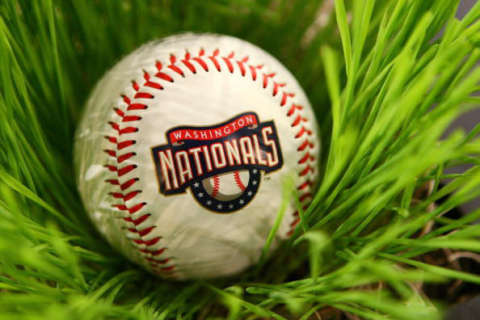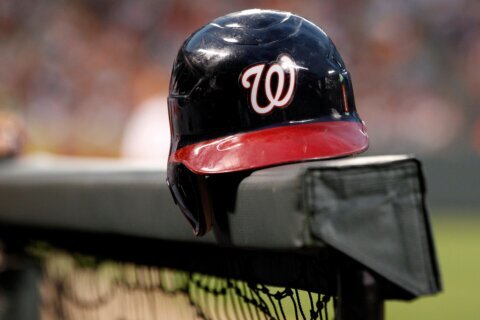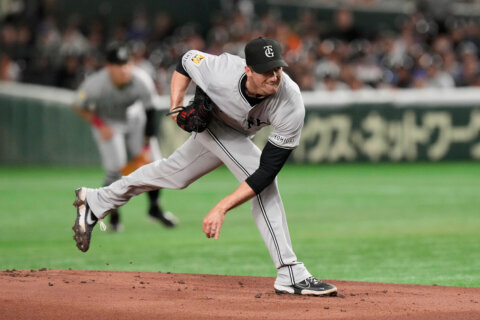The Nationals are under .500 as the July calendar winds down and the trading deadline looms.
As they near Saturday, July 31 — and remember, since 2019, there has been no August waiver-wire exemption — they have to decide if they’re buyers or sellers.
The sweep by the Orioles doesn’t deliver a knockout blow, but a poor showing this week at Philadelphia might push them over the edge.
Is Nats GM Mike Rizzo looking to load up the roster, rotation and lineup, or pad the farm system with prospects and lighten the contract load?
Last year’s deadline saw minimal movement leaguewide, not only because of the shortened season but also because there was a reluctance — due to the pandemic — to move players into new surroundings. There was also a limited field of prospects available as the entire minor leagues were shut down in 2020.
The Nats were 12-20 and in fifth place of the NL East as Aug. 2020 ended — the short season made for an altered deadline — and thus no moves of note were made. But previously, the team has been in contention annually: first or second place on Aug. 31 in 2012-2017 and 2019.
When you make the postseason five times in an eight-year span like the Nationals, you are more often than not in the buyer’s position, although they didn’t exactly wow the world their first year as a contender in 2012. The big move that season — and keep in mind they wound up shutting down Stephen Strasburg — was a waiver-wire swap that brought Kurt Suzuki from Oakland for fellow catcher David Frietas.
(The former 15th-rounder would play 59 games over three MLB seasons for three different teams.)
The following August, they sent Suzuki back to Oakland for minor-league reliever Dakota Bacus, who is still in the Nats system at AAA in 2021 — talk about a slow payout.
Here’s a look at other July 31 moves (statistics are as of July 25, 2021).
2014 (58-48 and first place on July 31): Infielder Asdrúbal Cabrera (more like a stocking stuffer than a gift wrapped under the tree) was brought to D.C. for reserve Zach Walters. Cabrera didn’t set the world on fire, but was a decided upgrade over Danny Espinosa at second base (just one error and 20 runs plus 21 RBI over 49 games; Espy had 31 runs plus 27 RBI over 114 games played). Walters last saw action in a major league game during the 2016 season.
2015 (54-47 and in first by two games): Closer Jonathan Papelbon was brought to South Capitol Street to shore up the bullpen. The price tag? Nick Pivetta, who went 19-30 with a 5.50 ERA as a starter for the Phillies from 2017 to 2020. (He was dealt to Boston last summer.)
And Papelbon didn’t exactly bolster the bullpen. You could say he blew it up as the veteran was ineffective, Drew Storen went on a downward spiral that ended when he broke his hand punching a locker, and Papelbon put his hands on the throat of NL MVP Bryce Harper in a dugout dust up. His season ended shortly thereafter when the team suspended him.
2016 (61-44 and in first by four games): New year, new closer. This time, it was Pittsburgh’s Marc Melancon … and the right-hander delivered 17 saves in 18 chances, with an ERA of 1.82 over 30 appearances and — almost as important — allowed the team to jettison Papelbon. The price tag was pitchers Felipe Rivero and Taylor Hearn. Hearn made his MLB debut for Texas in 2019 and owns a 4.73 career ERA over 46 appearances.
Rivero changed his last name to Vásquez (to honor his sister) and made a pair of All Star teams with the Pirates. But this is where the profit-and-loss examination of trades departs from on-the-field production. Vásquez was arrested in 2019 on charges of computer pornography, and was convicted this past May on 15 counts stemming from a relationship with a girl that started when she was 13 years old. He’s still facing charges in Missouri and Florida related to the same victim.
2017 (63-41 and in first by 14 games): Bullpen depth was the key with the acquisition of Brandon Kintzler for 20-year-old left-hander Tyler Watson and $500,000 in international bonus pool money. The 24-year-old Watson has made 15 appearances for Minnesota’s high-A club in Cedar Rapids this year, posting an ERA of 1.88. Kintzler was the 7th-inning man in 2017 (3.46 ERA over 27 appearances) and saw setup work for the most part in 2018 before being dealt.
The Nats made a bigger deal July 16, when they traded pitchers Blake Treinen and Jesús Luzardo plus infielder Sheldon Neuse to Oakland for relievers Ryan Madson and Sean Doolittle, who joined Kintzler to form the team’s late-inning brigade. Treinen has made an All-Star team and won a World Series with the Dodgers, Luzardo has made 31 MLB appearances with the A’s, and Neuse drove in 102 runs for AAA Las Vegas in 2019 before reaching the major leagues the following season and then being traded to the Dodgers this past winter.
2018 (53-53 and in third, 5.5 games back, five games back in the Wild Card chase): Minimal movement at the nonwaiver trading deadline for the Nationals, who opted not to bring in a starting pitcher nor a catcher (both needs). Instead, they dealt Brandon Kintzler at the deadline to the Cubs for minor-league pitcher Jhon Romero, who’s in AA now.
The final year of the August waiver-wire swapping saw the team ship Ryan Madson to the Los Angeles Dodgers for pitcher Andrew Istler (his last professional appearance was in 2019), Daniel Murphy to the Chicago Cubs for infielder Andruw Monasterio (who became the player to be named later in the deal that brought Yan Gomes to D.C.), and Shawn Kelley to Oakland for bonus slot money.
2019 (57-51 and in second place by 6.5 games, with a half-game lead for the Wild Card): The Nats needed bullpen help, and they got it in the form of Daniel Hudson, parting with pitcher Kyle Johnson. He is still in the Blue Jays’ system (AA), where he sports a 1.80 ERA over 15 appearances this year. Hudson went 3-0 with 6 saves and an ERA of 1.44 over 14 appearances in 2019 before notching saves in the Wild Card Game, Game 4 of the NLCS sweep, and two other playoff games.
Hudson also was the winning pitcher in Game 5 of the NLDS and was on the mound when the Nats won Game 7 of the World Series. It was well worth it.
They also traded for Seattle relievers Roenis Elías (who got injured that year and hasn’t pitched in the majors since) and Hunter Strickland (24 regular season appearances followed by a pair of postseason appearances), who is on his fourth team since leaving the Nats after 2019. They gave up three pitchers: Aaron Fletcher, who has posted a 12.38 ERA in 10 MLB appearances with the Mariners; right-hander Elvis Alvarado (9.00 ERA in 20 single-A appearances this year in the Seattle system); and lefty Taylor Guilbeau, who pitched in 25 games for Seattle in 2019-2020 before being released by Arizona this year.








